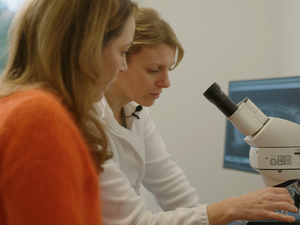
Buzzing Concerns
Bees are an integral part of our ecosystem and play a vital role in pollinating crops, plants, and flowers. However, bees face a variety of challenges, including diseases that can have a devastating impact on their health and well-being. To gain a better understanding of the types of diseases that affect bees and what can be done to prevent and treat them, we sat down with Dr. Kristina Loth. In this interview, Kristina will share her insights on the most common bee diseases, the signs and symptoms to look out for, and the latest treatments available.
Hi Kristina! Thanks for agreeing to share a bit of your expert bee knowledge with our community. Let’s get straight to the most important question: What are the most common bee diseases?
The most common diseases among bees in Germany are infestation with the Varroa mite itself, as well as the diseases that it brings with it. These are virus infections that paralyze the bees or cripple their wings. There is also an increasingly common occurrence of diarrhea, also known as bee dysentery or nosemosis. And of course, there is the American foulbrood, too. The Varroa mite and American foulbrood cause the most damage.
Depending on the disease, the symptoms vary. Sometimes the colonies become restless, spots accumulate at the flight entrance (signs of diarrhea), and the larvae do not develop properly. Furthermore, a thick yellow slime is often visible when opening the comb cover. Bee yields decrease and flight activities may decrease as well.
The cause is usually a very high infection pressure and inadequate or unsuccessful treatment. and inadequate or unsuccessful treatment. Another cause is not enough treatment because one does not want to destroy an entire bee colony. Increasingly, this is also due to ethical considerations as well as economic losses.
What steps do you think beekeepers should take to mitigate the spread and occurrence of bee diseases within their colonies?
Hygiene is always the most important thing when you want to keep a large number of animals living together in good health. There are different acids and flame techniques to minimize pathogens in the beehive.
In your opinion, what is the optimal frequency for inspecting bee colonies to ensure timely detection of disease symptoms?
The bees should ideally be examined constantly. Whereby, it is also important to document the results. Graphs showing the trends of various factors are important in order to recognize whether everything is okay or whether the parameters are beginning to change and deviate from the norm. This could be an initial indicator of a disease.
What would you say are some common mistakes that beekeepers tend to make when it comes to preventing and treating bee diseases?
I do think that many beekeepers make a great effort to prevent bee diseases and are very successful in doing so. The only mistakes that are likely to occur are due to ignorance. It must not be forgotten that bees are important organisms. This is different from having a chicken in the garden, because the impact of bees on all our ecosystems is much greater.
This is something that especially laypeople and hobby beekeepers must understand. The best beekeeper can keep their colony healthy, but if some layperson places a sick colony unknowingly 300 meters away in their own garden, the healthy bee colony will become sick anyways.
Could you share some of the recent advancements or breakthroughs in the treatment of bee diseases?
The latest developments are moving towards the revitalization of sick bee colonies, so that no actual medications need to be used. An example of this is the bee sauna. In this method, the beehive is heated to a level that the bees can tolerate, but the mites cannot survive.
Additionally, there are so-called powdered sugar experiments. In this method, the bees are encouraged to clean themselves, which eventually kills the mites.
Another possible method is to introduce other organisms into the hive, such as the book scorpion, to observe whether it could help the bees rid themselves of the mites.
There are also ideas that are being promoted as so-called bee vaccinations. Ultimately, the idea is to give the queen something that makes the eggs she lays in individual combs more resistant to pathogens. It is important to know that bees are insects. They do not have an immune system or blood like we do, so classical vaccination ideas with antibody formation like in humans are not applicable.
Do you think that technologies like cameras or sensors could play a role in detecting and preventing bee diseases at an early stage?
Of course, but it takes more than just cameras and sensors in the end, and that’s where programmers and other clever computer heads come into play.
In addition to the classic values that are already being measured, such as temperature, weight, noise level, and humidity, collecting other data also makes sense. For example, location data could be collected. How many colonies are in the vicinity? How close are they? How big are they? How old are they? And what flight routes do they use?
Further data could also be collected in agriculture. Important questions would be: What flowers do the bees find? How much sun shines on the beehive? What is the precipitation level? How is the weather?
And of course, the data from and around the beehive also play an essential role. The possibilities for collecting data are endless. Cameras at the flight entrance or neural networks could be installed that count how many bees return with a mite on their back. How much pollen do the bees’ legs contain? How many bees fly in and out per hour? What is the size distribution? Are there any signs of diarrhea? And so on.
The same applies to infrared or similar, which can already be used to see in the capped honeycomb whether there are signs of foulbrood, whether mites are crawling there, or whether the growth of the larvae is even.
Then someone clever finds regularities, develops algorithms that puzzle the data with the existing biological and medical knowledge and develop a kind of bee barometer.
Finally, comes the last and most difficult step: the beekeeper has to be able to analyze and interpret the data correctly and make improvements or changes accordingly.
If we would look at beekeeping from a different point of view, it would not only be the impetus for the perfect hive with a healthy colony of bees, but also the impetus for a different understanding of urban greening and agriculture




